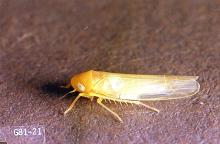Includes Edwardsiana rosae
Pest description and damage Rose leafhoppers are small (range from 0.14 to 0.16 inch in length), active, whitish-green insects which run forward, backward, or sideways when disturbed. The nymphs (immature) are white with red eyes. Rose leafhoppers feed on the leaves, causing tiny, white, or pale stippling or blotches that resemble, but are larger than, spider mite stippling. Injured leaves may drop prematurely. The egg-laying in the fall also wounds the canes, providing entry points for fungal pathogens. Cast skins are found on the undersides of leaves. Leafhopper damage is mainly aesthetic.
Biology and life history The insect overwinters as eggs within the cane bark of wild or cultivated rose or on caneberries. Eggs hatch in the spring, and the emerging nymphs feed on the leaves. When mature, the nymphs may leave roses for summer hosts that include species of Cornus, Quercus, Prunus, Crataegus, Malus, Populus, and Acer. There are several generations each year (three in eastern Washington).
Pest monitoring Check for leafhoppers and shed skins early in the season to determine if any treatment is needed.
Management-cultural control
Leafhopper damage is mainly aesthetic. Tolerate this cosmetic damage, unless there is evidence the infestation will be more severe than usual.
Management-biological control
Several natural predators feed on leafhoppers, including damsel bugs and assassin bugs. Avoid use of broad-spectrum insecticides that may kill these predators.
Management-chemical control
See Table 1 in:
Chemical Control of Landscape Pests
For more information
See "Leafhopper" in:



